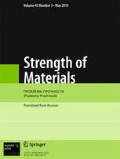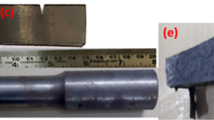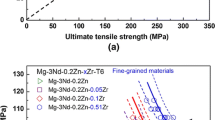Conclusions
-
1.
The structure of a fracture surface is affected by the shape, size, and distribution of the graphite grains. The failure rate is also controlled by the graphite inclusions.
-
2.
The path of a crack is uniquely determined by the graphite inclusions and is independent of the form of loading for the pearlitic and bainite forms of matrix in grey and alloyed cast irons, and it is also independent of the failure conditions.
-
3.
The total failure time is governed not only by the deformation characteristics but also by the relaxation ones.
-
4.
The failure rate in the matrix is constant in these materials and is governed by the stress concentration around the graphite inclusions.
-
5.
Mechanical hardening up to a critical value on the whole does not reduce the tendency to brittle failure but does reduce the relaxation time around the graphite inclusions.
Similar content being viewed by others
Literature cited
V. M. Finkel', The Physics of Failure [in Russian], Metallurgiya, Moscow (1970).
I. S. Guz', A. P. Lyubchenko, V. M. Matsevityi, et al., “The effects of magnesium content on crack propagation characteristics in cast iron under dynamic bending,” Liteinoe Proizvod., No. 9, 13–14 (1976).
A. N. Podgornyi, I. S. Guz', A. P. Lyubchenko, et al., “Failure of grey magnesium cast iron in dynamic loading,” Probl. Mashinostr., No. 6, 11–17 (1978).
I. S. Guz', A. P. Lyubchenko, V. M. Matsevityi, et al., “The failure kinetics of magnesium cast iron examined by high-speed cine photography,” Probl. Prochn., No. 12, 60–64 (1977).
I. S. Guz', V. I. Gazov, and S. L. Molodtsov, “The effects of structural state in N36Khl2TYu and N36-Khl2TYuM8 aging alloys on the kinetics of failure,” Probl. Mashinostr., No. 3, 39–42 (1976).
V. P. Severdenko, É. I. Tochinskii, and V. I. Élin, “Crack nucleation and development,” Dokl. Akad. NaukSSSR,158, No. 6, 1318–1319 (1964).
V. S. Ivanova, V. G. Kudryashov, Yu. K. Shtovba, et al., “Fractographic examination of viscous failure in aluminum and titanium alloys,” Probl. Prochn., No. 11, 25–30 (1972).
V. Z. Parton and E. M. Morozov, Mechanics of Elastoplastic Failure [in Russian], Nauka, Moscow (1974).
I. S. Guz', A. P. Lyubchenko, V. M. Matsevityi, et al., “Effects of surface hardening on the failure kinetics in alloyed grey cast iron,” Probl. Prochn., No. 6, 63–65 (1979).
Author information
Authors and Affiliations
Additional information
Translated from Problemy Prochnosti, No. 2, pp. 62–65, February, 1981.
Rights and permissions
About this article
Cite this article
Molodtsov, S.L. Effects of the structural state on the failure of magnesium-modified cast iron. Strength Mater 13, 198–201 (1981). https://doi.org/10.1007/BF00762703
Received:
Issue Date:
DOI: https://doi.org/10.1007/BF00762703




